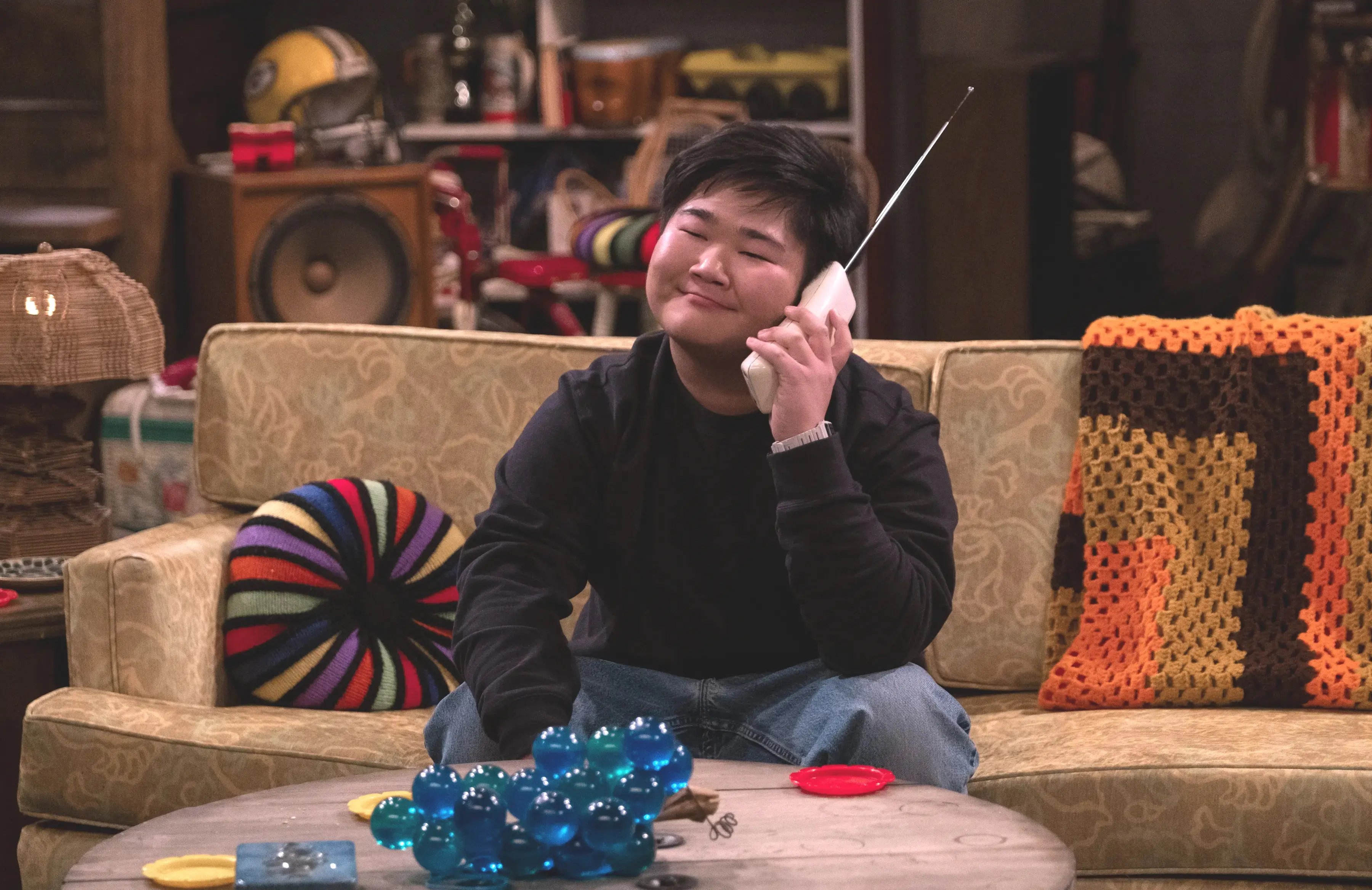Gay Pride Remains Complicated on That '90s Show
-
 Reyn Doi as Ozzie on That '90s Show (Photo: Patrick Wymore/Netflix)
Reyn Doi as Ozzie on That '90s Show (Photo: Patrick Wymore/Netflix)In some ways Netflix’s That ‘90s Show is a reminder that Hollywood is in a rut. After all, it’s yet another new TV series that continues, reboots, or otherwise extends the brand of a an older hit, and while its first season has some sweet and funny moments, it often feels like it’s ticking boxes on a nostalgia checklist for people who once enjoyed That ’70s Show. But the connection to the older series also makes That ’90s Show a handy symbol of just how far television has come with regard to queer representation. It may be structured like an old-school sitcom, but it’s also part of the modern world.
Back in December 1998, That ’70s Show was in its first season on Fox when Joseph Gordon-Levitt made a one-episode appearance as Buddy Morgan, lab partner of lead character Eric Forman (Topher Grace). Buddy was smart and rich and had a cool car, and as it happened, he was gay. Eventually, he even worked up the nerve to kiss Eric right on the mouth.
This was a big deal for several reasons. For one, it was the first male-male kiss on primetime network television. Even though Ellen Degeneres’ character had come out on Ellen the year before and Roseanne had caused a ruckus with a lesbian smooch back in 1994, man-to-man affection was considered quite taboo at the time. So while Eric’s character was straight, that kiss was still groundbreaking. Perhaps even more significantly, Buddy didn’t get punished for it. Nobody in the episode shamed or berated him, and nobody expressed any homophobic disgust when he wasn’t in earshot. Even if he didn’t get the guy, he still got to be a gay teenage boy living a normal life.
There are plenty of theories about why Buddy never returned to That ‘70s Show, including that the audience rejected the idea of a gay character. That may or may not be true -– the internet is full of rumors about this, but short on facts -– but either way, Buddy matters. So does Fenton, the character Jim Rash played for several episodes in That ’70s Show’s last few seasons. Fenton never explicitly came out, but since half the things he said were gay innuendos, it wasn’t hard to guess which team he was on. He was an unapologetic bitch in the Beverly Leslie mold, and though he was funny, he was not the object of ridicule. Once again, he allowed That ’70s Show to be a most-of-the-way ally for the queer community, pushing things a little beyond the norm without going full gay like Will and Grace or Buffy the Vampire Slayer.
By contrast, Ozzie (Reyn Doi) is openly gay from the moment he appears on That ’90s Show. He talks about his attraction to men, his boyfriend in Canada, and his orderly plan for coming out to everyone in his life. None of his friends give him grief about it, and when he starts coming out to adults, they accept him, too. Even more telling, most of Ozzie’s storylines aren’t even about his sexuality. Instead of always being “the gay one,” he’s the sarcastic, witty one who happens to be gay. He’s the one who convinces everyone to go to a rave and the one who carries out a ludicrous plan to recover a stash of pot from an old man’s coat pocket. Even more than a string of characters announcing their support for his identity, this integration into the tomfoolery proves he’s not just a token.
That’s not to say there’s no room for improvement. Almost all of the straight kids on the show have an on-screen romance, and there’s even a subplot about two of the girls getting wasted and making out. Ozzie, however, never even gets to hug another boy, let alone kiss one. The series kind of addresses this when Ozzie explains how frustrating it is to be a gay kid in small-town Wisconsin, and it does let his Canadian boyfriend be a real person instead of a figment of his imagination. Still, it would be nice if he got to experience some of the love that the other characters come by so easily. Since hit shows like Heartstopper are built around gay boys falling in love, it wouldn’t even be revolutionary.
Then again, That ’90s Show is still set in the 1990s, the era when the country melted down over women kissing on Roseanne. Back then, it really would have been hard for a kid like Ozzie to find a boyfriend in his little town. So even though the series is being created in the present day, there’s a poignant historical accuracy to his exclusion from the love lives of his otherwise welcoming friends. Similarly, there’s a wistful sting to Fenton’s appearance late in the season. 20 years later, he’s still not out, which might seem retrograde to modern audiences but makes unfortunate sense for a man trying to navigate the Clinton years. So it goes with the march of history and television’s attempt to capture it. In 25 years, maybe That ’20s Show can bring Ozzie back as a thriving adult getting everything he wants. And maybe audiences of the future can think about all the ways the world has advanced since the days when That ’90s Show was produced.
Mark Blankenship has been writing about arts and culture for twenty years, with bylines in The New York Times, Variety, Vulture, Fortune, and many others. You can hear him on the pop music podcast Mark and Sarah Talk About Songs.
TOPICS: That '90s Show, Netflix, Ellen_(ABC sitcom), Roseanne, That '70s Show, Joseph Gordon-Levitt, Reyn Doi, Topher Grace